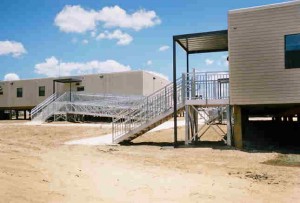 Construction safety is critical, and slips and falls from ramps, along with platforms, fixed ladders and stairs, cause the majority of jobsite accidents. OSHA compliant ramps and walkways will bring your workplace into compliance and provide safe walking/working surfaces for your workers.
Construction safety is critical, and slips and falls from ramps, along with platforms, fixed ladders and stairs, cause the majority of jobsite accidents. OSHA compliant ramps and walkways will bring your workplace into compliance and provide safe walking/working surfaces for your workers.
REDD Team is a leading national manufacturer of premium quality OSHA-compliant aluminum access products that are designed to meet your requirements. From design and detailing to manufacturing and shipping, we quickly and accurately provide access solutions with a product line that features quick onsite assembly.
OSHA Standards for Ramps
Ramps are covered under OSHA standard 1926.451(e)(5) and 1926.651(c). Following is a summary of the guidelines for buildings under construction, during excavation, and the general requirements:
- In buildings under construction, ramps must be well lit while the construction is underway.
- At excavation sites where there is digging to depths of 4 feet or more, ramps must be provided and remain in place until the completion of work. They must be made of slip-resistant material and extend from the surface to the bottom of the excavation site.
- Such ramps may be earthen, wood or metal, but only a competent person qualified in structural design.
- If the ramp consists of more than one piece, the pieces must be connected to each other to prevent displacement and be identical in thickness.
- In general, ramps and walkways that are more than 5 feet above lower levels shall have compliant guardrail systems.
- No ramp shall incline more than a slope of 1 vertical to 3 horizontal (20° above the horizontal).
- If the slope of a ramp is steeper than 1 vertical in 8 horizontal, the ramp must have cleats not more than 14 inches apart that are securely fastened to the planks to provide secure footing.
If your work involves longshoring, refer to OSHA standard 1918.25 for special rules that apply to bridge plates, gangways and ramps and to 1918.86 for cargo handling.
Worker Protection
Ramps are also frequently used with forklifts to lift and move heavy or large objects safely, but there is always a danger of forklift tipover when traveling up or down ramps. The following tips can help prevent accidents or workplace deaths in construction areas where workers must use ramps to access and exit inclines, with or without a load.
- Always look in the direction of travel.
- Never turn on ramps. Turn before the ramp to place forks in proper direction.
- Maintain a safe distance from the edges of a ramp.
- When traveling with a load, the load should point up the incline, regardless of direction of travel.
- When going up the ramp, drive forward; when going down the ramp, drive in reverse with forks pointed up the grade. When walking with a pallet truck with or without a load, the forks should be pointed downgrade, regardless of direction of travel.
- When traveling empty, the forks should point downgrade, regardless of direction of travel.
- When going up the ramp, drive in reverse with forks pointed downgrade; when going down the ramp, drive forward with forks pointed downgrade.
- A spotter should be used whenever a load blocks the driver’s view.
If you need ADA-compliant wheelchair ramps or other aluminum access products for access to site-built or portable buildings or other industrial walkways, platforms or stairs, REDD Team provides safe and low maintenance solutions in a variety of sizes that require no field welding.
Following the OSHA standards for ramps will help you achieve a safer work environment and healthier employees. Get in touch with us at (800) 648-3696 to learn more.

